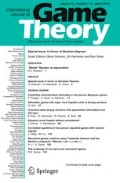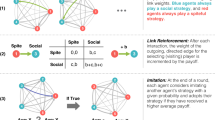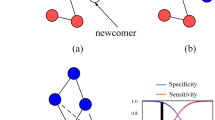Abstract
This paper extends previous work on evolutionary games by introducing non-trivial memory into a model where information flows and interactions are captured using networks, as in Alós-Ferrer and Weidenholzer (J Econ Theory 143:251–274, 2008). We consider two-player \(K \times K\) coordination games and analyze best response dynamics as well as imitation dynamics. We show that for any arbitrary information network, including those with asymmetric information exchanges, the introduction of non-trivial memory corroborates the results of previous studies: with best response, agents select the \(\frac{1}{2}\)-dominant strategy while imitators favor efficiency. Furthermore, we expose the sensitivity of the efficiency results to the interaction patterns.


Similar content being viewed by others
References
Alós-Ferrer C (2004) Cournot versus walras in dynamic oligopolies with memory. Int J Ind Org 22:193–217
Alós-Ferrer C (2008) Learning, bounded memory and inertia. Econ Lett 101:134–136
Alós-Ferrer C, Shi F (2012) Imitation with asymmetric memory. Econ Theory 49:193–215
Alos-Ferrer C, Weidenholzer S (2006) Imitation, local interactions, and efficiency. Econ Lett 93:163–168
Alós-Ferrer C, Weidenholzer S (2007) Partial bandwagon effects and local interactions. Games Econ Behav 61:1–19
Alós-Ferrer C, Weidenholzer S (2008) Contagion and efficiency. J Econ Theory 143:251–274
Bergin J, Lipman BL (1996) Evolution with state-dependent mutations. Econometrica 64:943–956
Dasgupta S, Papadimitriou C, Vazirani U (2006) Algorithms. McGraw-Hill, New York
Durieu J, Solal P (2003) Adaptative play with spatial sampling. Games Econ Behav 43:189–195
Ellison G (1993) Learning, local interaction and coordination. Econometrica 61:1047–1071
Ellison G (2000) Basins of attraction, long-run stochastic stability, and the speed of step-by-step evolution. Rev Econ Stud 67:17–45
Foster D, Young P (1990) Stochastic evolutionary game dynamics. Theor Popul Biol 38:219–232
Harsanyi J, Selten R (1988) A general theory of equilibrium in games. MIT Press, Cambridge
Jackson M, Watts A (2002) On the formation of interaction networks in social coordination games. Games Econ Behav 41:265–291
Kandori M, Mailath G, Rob R (1993) Learning, mutation and long-run equilibria in games. Econometrica 61:29–56
Matsui A (1991) Cheap-talk and cooperation in a society. J Econ Theory 54:245–258
Mengel F (2009) Conformism and cooperation in a local interaction model. J Evolut Econ 19:397–415
Morris S (2000) Contagion. Rev Econ Stud 67:57–78
Morris S, Rob R, Shin H (1995) \(p\)-dominance and belief potential. Econometrica 63:145–157
Robson A (1990) Efficiency in evolutionary games: Darwin, Nash and the secret handshake. J Theor Biol 144:379–396
Robson A, Vega-Redondo F (1996) Efficient equilibrium selection in evolutionary games with random matching. J Econ Theory 70:65–92
Sarin R (2000) Decision rules with bounded memory. J Econ Theory 90:151–160
Young P (1993a) The evolution of conventions. Econometrica 61:57–84
Young P (1993b) An evolutionary model of bargaining. J Econ Theory 59:145–168
Young P (1998a) Conventional contracts. Rev Econ Stud 65:773–792
Young P (1998b) Individual strategy and social structure. Princeton University Press, Princeton
Acknowledgments
I am particularly grateful to Fabrice Collard and Paul Pezanis-Christou for their interest in this paper, the multiple discussions we had and their very valuable support. I also would like to thank two anonymous referees for their constructive comments, Alexander Matros, Robert Garrard, Firmin Doko Tchatoka, Dimitriy Kvasov, Matthew Jackson, Kieron Meagher, Mandar Oak and audiences at UNSW, ANU and Massey University for their valuable comments and numerous suggestions. Also thanks to Mark Dodd, Steven Hail, Ros Whysall, Sam Henderson and Markus Brueckner for their comments at different stages of this manuscript.
Author information
Authors and Affiliations
Corresponding author
Appendix
Appendix
1.1 Proof of Proposition 1
We define \(R_{p}\), the set of SCCs containing agents who are neighbors to other agents in \(C_{p}\), as follows:
Without loss of generality, let all source SCCs be of order 1. Denote \(O_{C_{p}}\) the order of \(C_{p} \in {\mathcal {C}}\) and define it as:
This creates a partial order on the SCCs of the information network. This partial order is used to describe how a given action propagates from one SCC to another. In what follows, we first show that the states described in Proposition 1 are either absorbing or part of an absorbing set. We then demonstrate that these absorbing states are reached with positive probability from any arbitrary state.
First, consider \(C_{p} \in {\mathcal {S}}\). By definition, \(\text {there are no} \; i \in C_{p} \; \text{ and } \; j \in I \setminus C_{p}\) such that \(g_{ji}=1\). Hence if \(\theta _{C_{p}}=\theta ^{k}\) with \(k\) either \(1,2...K\), then agents in \(C_p\) can only sample action \(k\), thus maintaining the status quo. Therefore, when a source SCC follows a local convention, it never leaves it.
Consider now \(C_{p} \in {\mathcal {C}}\), with \(O_{C_{p}}=2\). By definition, \(\exists \; i \in R_{p} \; \text {and} \; \exists \; j \in C_{p}\) such that \(g_{ij}=1\). This means that some agents in \(C_{p}\) can sample the actions of some agents in \(R_{p}\). If \(\theta _{C_{l}}=\theta ^{k}\) for all \(C_{l} \in R_{p}\), then agents in \(C_{p}\) can only sample action \(k\) outside of \(C_{p}\). Since \(\theta _{C_{p}}=\theta ^{k}\) as per condition 2 of Proposition 1, no agents in \(C_{p}\) can sample an action different from \(k\) and hence, agents keep playing the same action. Applying this reasoning recursively to all SCCs of order greater than 2, one can see that if condition 2 is satisfied, then no agents change their action.
Therefore, when both conditions are satisfied, the system is in an absorbing state or set. Note that nothing is mentioned in Proposition 1 when \(\text {there are} \; C_{l} \in R_{p} \; \text {and} \; \; C_{m} \in R_{p} \; \text {such that} \; \theta _{C_{l}} \ne \theta _{C_{m}}\). In this case, agents in \(C_{p}\) may sample different actions outside of \(C_{p}\) and hence \(C_{p}\) may not follow a local convention. This can happen in an absorbing set.
The reasoning presented above holds whether all agents play BR or all agents play IM. We now need to show that these absorbing sets can be reached with positive probability from any arbitrary state.
Consider an arbitrary state \(\varTheta \) and without loss of generality let \(C_{1} \in {\mathcal {S}}\). Pick agent \(i\) in \(C_{1}\). With positive probability, since \(s \le m/2\), agent \(i\) can sample the same set of actions for \(s\) periods. Agent \(i\) thus plays a unique strategy \(k^{*}\) for his \(s\) most recent plays. From here, it is possible that agent \(i\) has a memory uniquely composed of \(k^{*}\), as he can sample from himself. If agent \(i\) is the only agent in \(C_{1}\), then \(C_{1}\) follows a local convention.
If \(card(C_{1})>1\), let \(A_i=\left\{ j \in C_1 \; s.t \; g_{ij}=1\right\} \). We apply the same reasoning as the one presented above to all agents in \(A_i \cup C_1\). We then do so recursively to all agents whose neighbors belong to \(A_i \cup C_1\) and so on. Thus, \(C_{1}\) can follow a local convention, which depends on agent \(i\)’s initial sample.
By applying a similar argument to all \(C_{p} \in {\mathcal {S}}\), we show that there is a positive probability that from any arbitrary local state, all source SCCs can follow a local convention. Once this is the case, we know that the local state within each of the source SCCs does not change.
Consider now \(C_{p} \in {\mathcal {C}} \setminus {\mathcal {S}}\), with \(O_{C_{p}}=2\). By definition, there exist \(i \in C_{p}\) and \(j \in L_{p}\) such that agent \(i\) can sample the same action \(k\) for \(m\) periods from an agent in one of the source SCCs. In which case, the memory of this agent in \(C_{p}\) who samples information from outside \(C_{p}\) contains only action \(k\). Following the reasoning described above, all agents in \(C_{p}\) can then have a memory containing only action \(k\). Furthermore, if all \(C_{l} \in L_{C_{p}}\) follow the same local convention \(\theta ^{k}\), then \(\theta _{C_{p}}=\theta ^{k}\) for all periods after that.
To complete the proof, the steps described above are repeated to SCCs of order 3, then to SCCs of order 4, and so on. This shows that the only absorbing sets are those described in Proposition 1.
1.2 Proof of Proposition 2
Consider \(C_{p} \in {\mathcal {S}}\) with \(\theta _{C_p}=\theta ^{j}\) where strategy \(j \ne s^*\), i.e. action \(j\) is not \(\frac{1}{2}\)-dominant. With positive probability, one agent within \(C_{p}\), agent \(i\), can make \(\left\lceil \frac{1}{2}s \right\rceil \) successive mistakes of playing action \(s^*\). All agents in \(N_{i} \cap C_{p}\) can then sample the string of mistakes and play \(s^*\) for \(s\) periods. This is enough to create a memory containing only action \(s^*\) for all agents in \(N_{i} \cap C_{p}\). The same reasoning can be applied to the neighbors of these agents, and the neighbors of the neighbors of these agents within \(C_{p}\) until \(\theta _{C_{p}}=\theta ^{*}\). Hence, \(R(\varTheta ) = \left\lceil \frac{1}{2}s \right\rceil \) for any absorbing state \(\varTheta \ne \varTheta ^{*}\). Similarly, we can prove that \(R(\varTheta ^{*}) = \left\lceil rs \right\rceil \), where \(r > \frac{1}{2}.\)
Consider \(\varTheta \) and denote \(J\) the number of source SCCs which follow \(\theta ^{j}\), where \(s_j \ne s^*\) under \(\varTheta \). The number of source SCCs which follow the local convention \(\theta ^{*}\) is therefore equal to \(Card({\mathcal {S}}) - J\). Thus, under \(\overline{\varTheta }\), \(J\) source SCCs follow \(\theta ^{*}\), and \(Card({\mathcal {S}}) - J\) source SCCs follow \(\varTheta ^j\) where action \(j\) is the action which requires the least number of mistakes to convince agents to switch from \(s^*\). Using the above arguments, we find that:
with \(r > \frac{1}{2}\). Hence, for \( \Theta \ne \Theta ^{*}\), the condition \(R(\Theta )>CR(\Theta )\) becomes \(\left\lceil \frac{1}{2}s \right\rceil > J\left\lceil rs \right\rceil + (Card({\mathcal {S}}) - J)\left\lceil \frac{1}{2}s \right\rceil \), which cannot be satisfied as \(\frac{\left\lceil rs \right\rceil }{\left\lceil \frac{1}{2}s \right\rceil } > 1\) and \(\frac{J+1-Card({\mathcal {S}})}{J} \le 1\). However, for \(\Theta = \Theta ^{*}\), and hence J=0, the condition becomes \(Card({\mathcal {S}} )< \frac{\left\lceil rs \right\rceil }{\left\lceil \frac{1}{2}s \right\rceil } \) and can be satisfied for some \(s\) and \(Card({\mathcal {S}})\).
Lemma 1
Consider an arbitrary information network and an interaction network satisfying Assumption 1. All agents use IM and \(s \ge 2\). Then, \(R(\varTheta ^1)=s\) and \(R(\varTheta ^k)=2\) for some \(k \in \{1,2,...,K\}\).
Proof
Consider \(\varTheta ^k \ne \varTheta ^1\) and \(C_p \in {\mathcal {S}}\). We have \(\theta _{C_p}=\theta ^k \ne \theta ^1\). If agent \(i \in C_p\), and his opponent simultaneously make the mistake of playing \(s_1\), then agent \(i\)’s memory contains the highest possible payoff. Agent \(i\)’s neighbors can then sample this payoff and thus choose \(s_1\). This also applies to the neighbors of agent \(i\)’s neighbors and so on. This is enough to leave \(B(\varTheta ^k)\), \(s_k \ne s_1\). Hence, \(R(\varTheta ^k)=2\), with \(k \; \text {either} \; 2,...K\).
Similarly, we compute the radius of \(\varTheta ^1\). Consider \(C_p \in {\mathcal {S}}\) which follows a local convention \(\theta ^1\). The system can leave \(B(\varTheta ^1)\) if one agent in \(C_p\) makes \(s\) successive mistakes of playing \(s_k \ne s_1\) rather than \(s_1\). This is because the neighbors of this agent can then draw samples uniquely composed of action \(s_k \ne s_1\), thus choosing action \(s_k\) themselves. Applying this reasoning recursively to the neighbors of these agents, and then the neighbors of the neighbors of these agents and so on, we have left \(B(\varTheta ^1)\). Hence, \(R(\varTheta ^1)=s\).\(\square \)
Lemma 2
Consider an arbitrary information network and an interaction network satisfying Assumptions 1 and 4. All agents use IM. Then, \(R(\varTheta )=1\) for any absorbing set \(\varTheta \ne \varTheta ^k\), for some \(k \in \{1,2,...,K\}\).
Proof
Since \(\varTheta \ne \varTheta ^k\), there exist \(C_{p} \in {\mathcal {S}}\) and \(C_l \in {\mathcal {S}}\) such that \(\theta _{C_{p}}=\theta ^{1}\) and \(\theta _{C_{l}}=\theta ^{k} \ne \theta ^1\). Also, from Assumption 4, there exist \(i \in C_p\) and \(j \in C_l\) such that \(m_{ij}=1\). Hence, there is a positive probability that agents \(i\) and \(j\) are paired and that agent \(j\) mistakenly chooses action 1, thus recording the highest possible payoff in his memory. Applying a similar reasoning to the one developed in the proof of Lemma 1, we have left \(B(\varTheta )\). Hence, \(R(\varTheta ) = 1\).\(\square \)
Lemma 3
Consider an arbitrary information network and an interaction network satisfying Assumptions 1 and 5. All agents use IM. Then, \(R(\varTheta ) =2\) for any absorbing set \(\varTheta \ne \varTheta ^k\), for some \(k \in \{1,2,...,K\}\).
Proof
Since \(\varTheta \ne \varTheta ^k\), there exist \(C_{p} \in {\mathcal {S}}\) and \(C_l \in {\mathcal {S}}\) such that \(\theta _{C_{p}}=\theta ^{k} \ne \theta ^1\) and \(\theta _{C_l}=\theta ^1\). From Assumption 5, agents in \(C_p\) [resp. \(C_l\)] cannot interact with agents from a SCC which follows \(\theta ^1\) [resp. \(\theta ^k \ne \theta ^1\)]. To leave \(B(\varTheta )\), one agent from \(C_p\) and the agent he interacts with can make two simultaneous mistakes. Or, an agent in \(C_l\) can make \(s\) successive mistakes. Using the arguments presented in the proof of Lemma 1, we can see that the value of the radius of \(\varTheta \) is 2.\(\square \)
Lemma 4
Denote by \(Card({\mathcal {S}})\) the total number of source SCCs and by \(0 \le P \le Card({\mathcal {S}})\) the number of source SCCs which follow \(\theta ^1\) under \(\varTheta \). Consider an arbitrary information network and an interaction network satisfying Assumption 1. All agents use IM. Then, for any absorbing set \(\varTheta \)
Proof
Consider \(\varTheta \) and denote \(P\) the number of source SCCs which follow \(\theta ^{1}\) under \(\varTheta \). By definition, \(P\) is also the number of source SCCs which follow \(\theta ^k \ne \theta ^1\) under \(\overline{\varTheta }\). The number of source SCCs which follow the local convention \(\theta ^{k} \ne \theta ^1\) under \(\varTheta \) is therefore equal to \(Card({\mathcal {S}}) - P\). We need to compute the number of mistakes needed to go from \(\overline{\varTheta }\) to \(\varTheta \). This means that \(Card({\mathcal {S}}) - P\) source SCCs need to switch convention from \(\theta ^1\) to \(\theta ^k \ne \theta ^1\), and \(P\) source SCCs should go from \(\theta ^k \ne \theta ^1\) to \(\theta ^1\).
When Assumption 4 is satisfied, only one mistake per source SCC following \(\theta ^k \ne \theta ^1\) is needed to switch local convention, and \(s\) mistakes are needed per source SCC following \(\theta ^1\) to have them also switch their local convention. Hence, \(CR(\varTheta )= s(Card({\mathcal {S}})-P) + P = s Card({\mathcal {S}}) + P(1-s)\) if Assumption 4 is satisfied.
With Assumption 5, agents from source SCCs following \(\theta ^k \ne \theta ^1\) cannot interact with agents playing action 1. Hence, each of these SCCs requires two mistakes to switch local convention. Furthermore, \(s\) mistakes per source SCC following \(\theta ^1\) is needed. Therefore, \(CR(\varTheta )= s(Card({\mathcal {S}})-P) + 2P = s Card({\mathcal {S}}) + P(2-s)\) if Assumption 5 is satisfied.\(\square \)
Rights and permissions
About this article
Cite this article
Masson, V. Information, interaction and memory. Int J Game Theory 44, 1015–1032 (2015). https://doi.org/10.1007/s00182-015-0463-0
Accepted:
Published:
Issue Date:
DOI: https://doi.org/10.1007/s00182-015-0463-0




